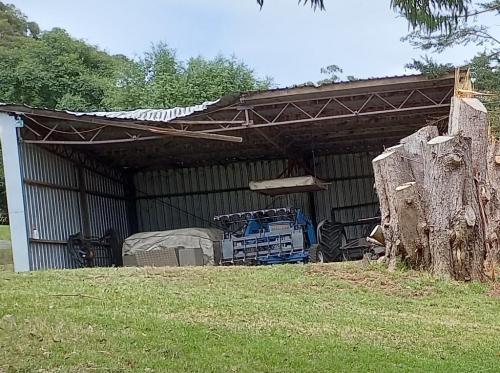05-18-2022, 10:13 PM
Hi all, haven't posted in a while but I have a question for the brains trust;
As I have too much money and not enough to do, I decided to drop a tree on my machinery shed a couple of months ago. I'm fabricating a new truss and am wondering whether I should build some camber into it. The photo shows the damaged truss and the structure generally:

The span is just under 9 meters, height of the truss is 500mm and material is 50x50x3mm SHS with 25x25x2 SHS webbing.
I've welded up the long rectangle and cut the material for the webbing but, having zero experience with this kind of truss, I'm wondering if it is necessary / advisable to pull some camber (arch) into the main frame before I weld in the bracing. As you can see, it supports the centre truss in the middle of the span without any posts in the shed. I'm thinking maybe 40-50mm of camber but would appreciate input if anyone has any experience / knowledge with this.
As I have too much money and not enough to do, I decided to drop a tree on my machinery shed a couple of months ago. I'm fabricating a new truss and am wondering whether I should build some camber into it. The photo shows the damaged truss and the structure generally:
The span is just under 9 meters, height of the truss is 500mm and material is 50x50x3mm SHS with 25x25x2 SHS webbing.
I've welded up the long rectangle and cut the material for the webbing but, having zero experience with this kind of truss, I'm wondering if it is necessary / advisable to pull some camber (arch) into the main frame before I weld in the bracing. As you can see, it supports the centre truss in the middle of the span without any posts in the shed. I'm thinking maybe 40-50mm of camber but would appreciate input if anyone has any experience / knowledge with this.
Lathe (n); a machine tool used in the production of milling machine components.
Milling Machine (n); a machine tool used in the production of lathe components.
Milling Machine (n); a machine tool used in the production of lathe components.





